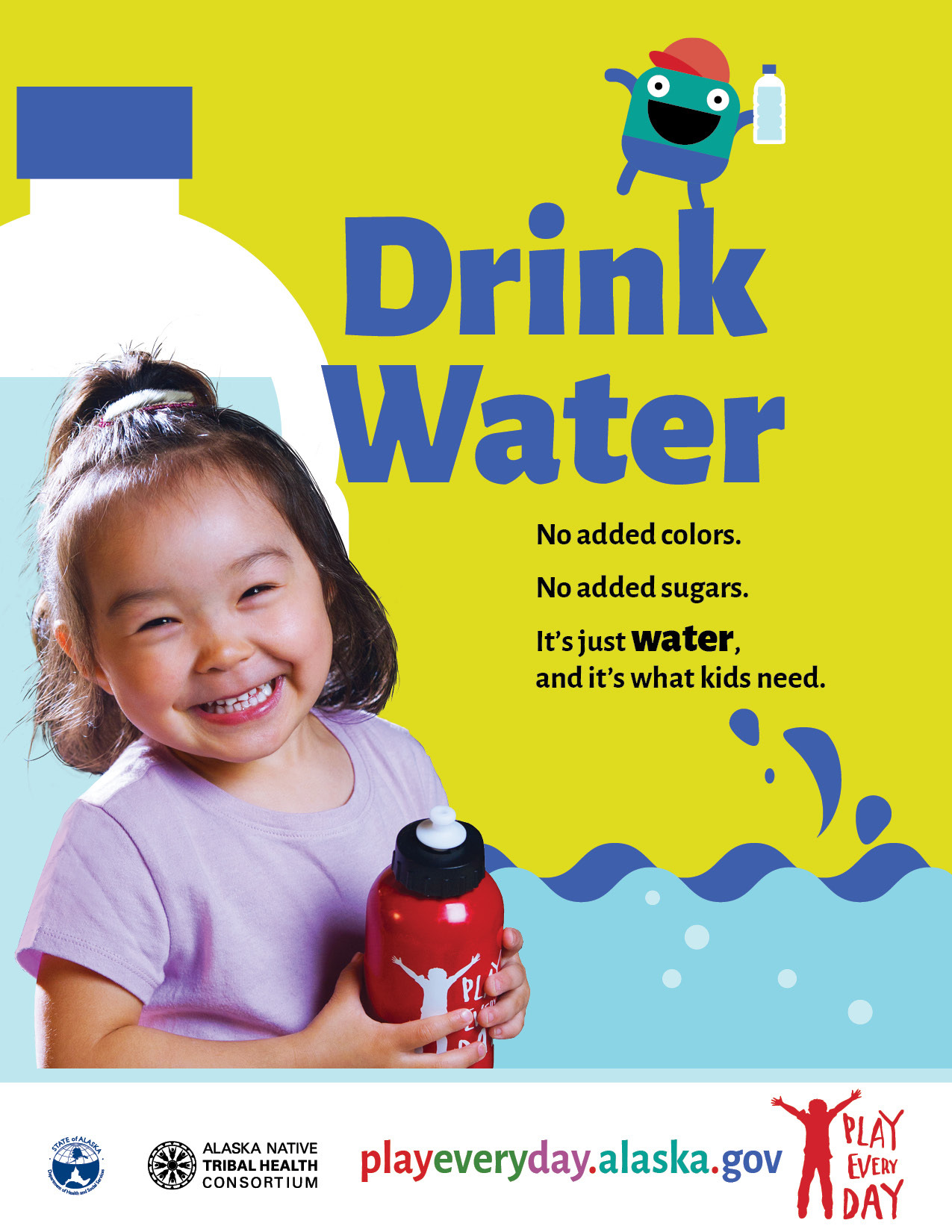New national dietary guidelines recommend infants and toddlers avoid sugary drinks and foods / Play Every Day blog update
Alaska Department of Health sent this bulletin at 12/29/2020 01:34 PM AKSTNew national dietary guidelines recommend infants and toddlers avoid sugary drinks and foods
DECEMBER 29, 2020 — The new 2020-2025 Dietary Guidelines for Americans issued today strengthen the recommendation to limit sugary drinks at younger ages. Infants and children younger than 2 years old should avoid all foods and drinks with added sugar, the guidelines state.
This new national recommendation for young children aligns with similar guidance issued in 2019 by the Academy of Nutrition and Dietetics, American Academy of Pediatric Dentists, American Academy of Pediatrics and American Heart Association. All four organizations agreed: Sugary drinks are not recommended for children ages 5 and younger. The 2019 report — called Healthy Drinks, Healthy Kids — said sugary drinks include fruit drinks and ades (like lemonade), which can be in liquid or powdered form; sweetened water; sports and energy drinks; and soda. The report also recommended not serving little children flavored milk, like chocolate or strawberry.
“The sugar we eat and drink day after day increases our chances of developing health problems that can last a lifetime, like type 2 diabetes, heart disease and obesity,” said Karol Fink, registered dietitian and manager of Alaska’s Section of Chronic Disease Prevention and Health Promotion. “We often focus on the sugar added to foods, but drinks are the main source of added sugars in many people’s daily diets. Parents can make a big improvement in their children’s health by cutting out those sugary drinks.”
New guidelines recommend people of all ages limit added sugar in drinks and foods
The Dietary Guidelines for Americans is issued every five years jointly by the U.S. Departments of Health and Human Services and Agriculture (USDA). Scientists along with nutrition and health experts work together to provide recommendations about what to eat and drink to stay healthy and reduce the chances of developing obesity and chronic diseases like type 2 diabetes, heart disease and cancer. In Alaska, about 1 out of 3 children is overweight or obese, and 2 out of 3 adults are overweight or obese.
The 2020-2025 report kept the recommendation first released in the 2015-2020 guidelines that states people ages 2 and older should limit added sugars to less than 10 percent of the calories they eat and drink each day. Added sugars are sugars, syrups and other sweeteners that are added to foods or drinks when they are processed or prepared. Added sugars do not include naturally occurring sugars, such as those in plain white milk and whole fruits.
Examples of sweetened foods include granola bars, sweetened breakfast cereals, cookies and cakes. It’s drinks, however, that can lead to much of our daily sugar intake. There is strong evidence that consuming sugary drinks is linked to obesity, type 2 diabetes, heart disease and tooth decay.
What does the recommended daily sugar limit look like when it comes to drinks? According to the dietary guidelines, a person eating 2,000 calories a day should limit daily added sugar to about 12.5 teaspoons. Just one sugary drink, like a bottle of soda, can take you over that limit (a 20-ounce soda can have 16 teaspoons of added sugar). A 16-ounce glass of a powdered orange drink — a common beverage in Alaska — has about 11 teaspoons of added sugar. A bottle of a sports drink can have 9 teaspoons of added sugar.
Added sugars can be tricky to spot because they go by many different names, such as honey, sucrose and high fructose corn syrup. That’s why it’s important to read the ingredient list on the back of a drink or food container to find all the added sugars. The updated Nutrition Facts labels tell you how much added sugar there is in a food or drink on the line called “Includes Added Sugars” under the “Total Carbohydrate” section.
The 2020-2025 dietary guidelines support Play Every Day’s mission to reduce the amount of sugary drinks that Alaska children and families consume every day. In Alaska, high consumption of sugary drinks starts at a young age. About 1 out of 3 Alaska 3-year-olds (31%) drinks some amount of sugary beverages every day, according to the 2018 Alaska Childhood Understanding Behaviors Survey. By high school, almost 1 out of 2 Alaska teenagers drinks one or more sugary beverages every day, as reported in the 2019 Youth Risk Behavior Survey.
Play Every Day is sharing new messages this year to encourage families to serve water or white milk instead of sugary drinks. One message focuses on helping families understand the large amount of sugar hiding in drinks commonly served to young children. Another message focuses on parents and caregivers modeling the choice to drink healthy beverages so children see that behavior and do the same.
New recommendations for infants, toddlers, and pregnant and breastfeeding women
The 2020-2025 dietary guidelines now provide recommendations from birth through older adulthood. The report is organized into sections that focus on life stages, including a new focus on babies and toddlers under age 2, as well as pregnant and breastfeeding women.
The new guidelines recommend that infants exclusively drink human milk for about the first 6 months of life. Drinking human milk should be continued through at least the first year of life, and longer if desired. If human milk isn’t available, infants can drink iron-fortified infant formula during the first year. Babies also should have supplemental vitamin D beginning soon after birth.
At about 6 months, babies can start eating foods that provide many nutrients, including vitamins and minerals, but include no or little added sugars, saturated fat and salt. That includes vegetables, fruits, whole grains and more. Parents should encourage babies and toddlers to eat a variety of foods, including those rich in iron and zinc. That’s particularly important for infants fed human milk, the guidelines state.
The highlights of the 2020-2025 Dietary Guidelines for Americans are published online. A short executive summary is published at this link. For more information and tips to choose healthier drinks, visit this Play Every Day web page.

Sign up to receive announcements for updates to Play Every Day's blog and website.
Play Every Day is a campaign with the Alaska Department of Health and Social Services to help Alaska children grow up at a healthy weight and encourage families to be physically active and choose healthy drinks. For more information, visit www.playeveryday.alaska.gov.


